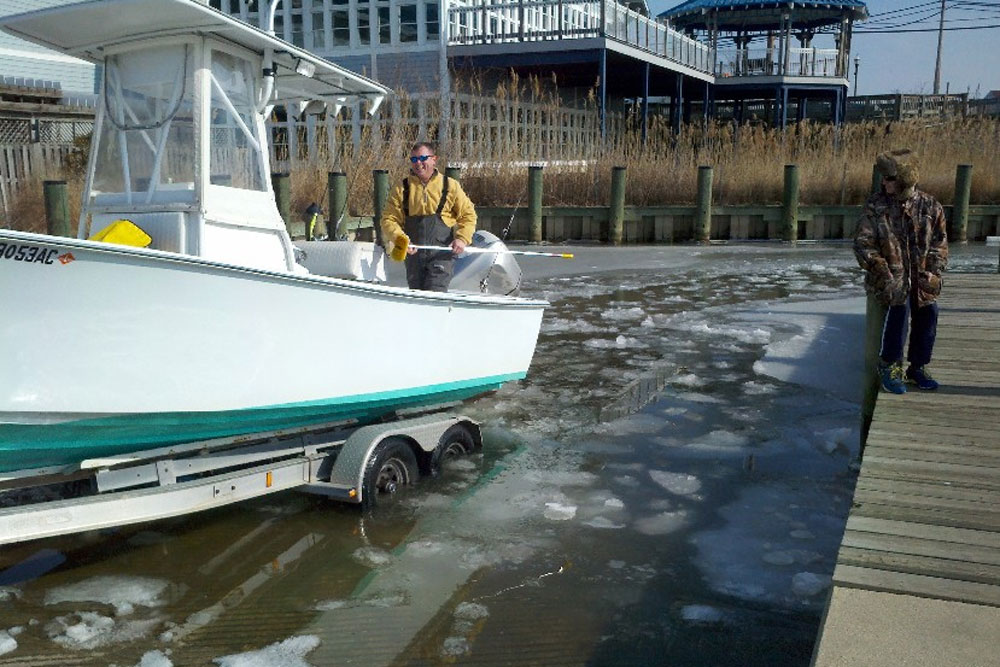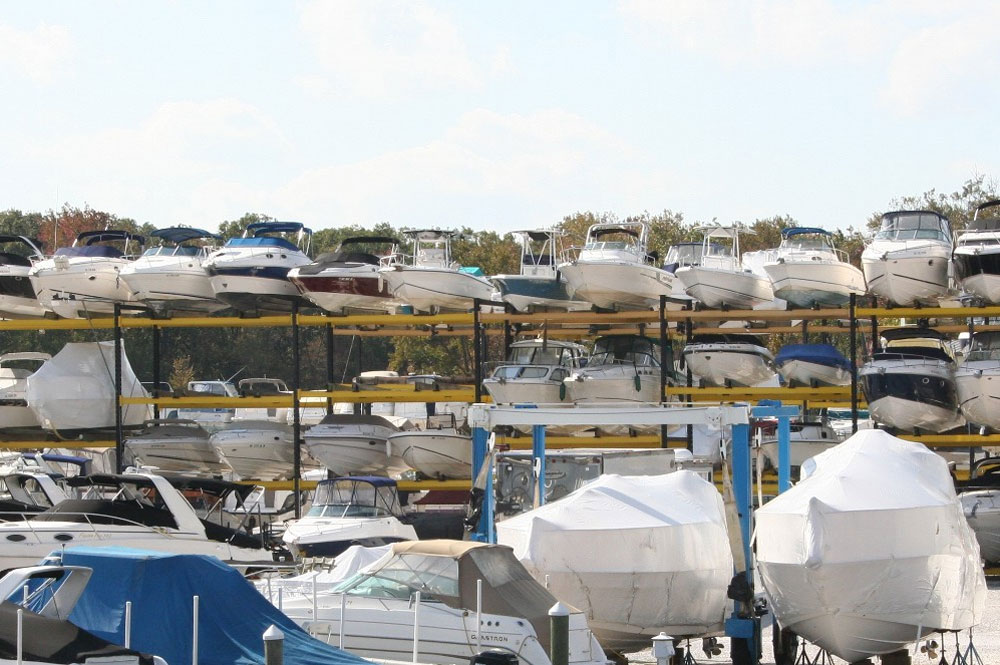Shrink Wrapping a Boat
We spoke with the experts to learn the ins and outs of heat shrink wrap and the boat shrink wrap process.
We hope you've read our article on How to Winterize a Boat and are preparing to do those end-of-season chores, which may well culminate with shrink wrapping your boat. We've been told for many years now that shrink wrap is a great way to protect a boat through the winter months, but even so, only a fraction of the boats out there get such treatment. Besides, there have to be downsides to shrink wrapping a boat. So, how do you know if you should have it done, or maybe even do it yourself? How exactly does shrink wrapping work? And what are the important things to look for in a shrink wrapping professional? To find out the scoop we spoke with a shrink-wrap expert, Dustin Hoover, VP of Atlantic Shrink Wrapping, Inc. Join in as he talks us through the important parts of shrink wrapping a boat, and watch how it's done first-hand.
“The main reason to shrink wrap your boat, obviously, is to protect it,” Hoover said. “It’ll keep out rain, snow, ice, and UV light.”
Hold on a sec, Dustin, doesn’t that regular old blue tarp accomplish the same exact thing?
“And unlike a tarp,” he continued, “properly installed shrink wrap will not leak. Period. It won’t ice up and collapse, you don’t need to brush off snow, and you won’t have to bail out puddled water, or anything like that. When the job is done right, you can basically forget about it until spring.”
Shrink wrap is a polyethylene which has UV inhibitors, and is formulated to shrink when heated to create a seal which is much tighter than the one you or I can make with a tarp and ropes. That seal not only keeps the weather out of your boat, it also prevents the stretching and tearing tarps commonly display after a few months in the elements.
Should You Shrink Wrap Your Boat?
So, what’s the down-side to shrink wrap? The expense. Even a small boat can cost several hundred dollars to shrink wrap, and protecting a large boat could cost you a lot more. A tarp and some rope, on the other hand, can be bought for peanuts. “You have to ask yourself,” Hoover said, “what’s your boat worth to you?”
Even if you spring for shrink-wrapping, you have to remember that you get what you pay for. “We shrink wrap 12 months out of the year because we're mobile, and we do many projects other than boats,” Hoover said. “But there are a lot of outfits out there that only shrink wrap a couple months out of the year, when boats need to be winterized. And when you have a 3,500-degree heat gun in your hand, you’d better know what you’re doing. If the installer is inexperienced he might end up scorching the boat, or worse—and many part-time installers don’t even have the insurance needed to cover that type of damage.”
What about those do-it-yourself kits? Unless you happen to have a propane-fired heat gun sitting around—a starter model used for shrink wrap costs around $700—this isn’t as economical as you’d think. And remember, your first learning experience will be on one of your most prized possessions. So for the vast majority of the boat owners out there, using heat shrink wrap simply isn't a DIY project.
There's one other potential down-side to using heat shrink wrap on a boat: once wrapped, there’s no way you can use it. For 99 percent of us this isn't a problem, but for those who are willing to break ice for a winter fishing trip or to enjoy cold-water activities like recreational oyster tonging, shrink wrap will prove frustrating when the opportunity to get out on the water arises.

You like to go boating even when there's ice at the ramp? Then heat shrink wrap probably isn't what you need.
The bottom line? If your boat represents a large investment and you want to protect it, a good shrink wrap job done by a real pro is the hands-down best way to safeguard your boat through the winter. But if your boat is old or inexpensive and your budget is tight, default back to that old tarp—and be ready to monitor and maintain it until spring.
Here are a few other shrink-wrapping details, to keep in mind:
- If you plan to trailer your boat while it’s wrapped, you need a “bullet wrap”. This is an aerodynamic design which incorporates strapping and a thicker plastic, to account for the strong winds encountered when towing. Be sure to mention that you’ll be towing it, before your shrink wrapper goes to work.
- A low-budget outfit may only wrap to the rubrail, while a first-class job goes all the way down the hull sides, to better protect the boat. Specify what you want, when getting a price quote.
- If you’ll need to get onto the boat to work on it during the winter, be sure to ask the shrink-wrapper to install a zipper door. This will cost a bit extra, but in many cases, the zipper door can be cut out in the spring and re-used next season.
- Make sure the shrink wrap is well vented. If it isn't, mildew is going to be a problem.
How to Shrink Wrap a Boat
To get more details on how to shrink wrap, our mid-western correspondent (and Outboard Expert) Charles Pluddeman spoke with Dr. Shrink, perhaps the largest supplier of shrink-wrapping materials in the world. Located in Manistee, Mich., Dr. Shrink sells wrap not just for boats but also for a wide range of industrial applications, like wrapping an entire building, or a locomotive. To get the skinny on boat wrapping, he spoke to sales manager Ryan Polcyn, who is featured in a how-to video on the Dr. Shrink website that offers a great tutorial on runabout wrapping – he’s the guy doing the work. The site also has lots of tips on prepping powerboats and sailboats for wrapping.
Polcyn says the number one problem he encounters with shrink-wrapped boats is moisture accumulation.
“The shrink-wrap material is non-permeable, so it’s important that the boat is as dry as possible before it’s wrapped, and that vents are installed in the wrap so it can breathe during storage,” says Polcyn.
You can help in this regard by cleaning out your boat before having it shrink wrapped. It’s a good idea to get any old food wrappers, bait cups and other items that might attract rodents out of the boat anyway. Polcyn said damp PFDs are a common source of moisture. You want to pull all the gear out of stowage compartments, let them dry out, and then leave the hatches open while the boat is stored. Pull the drain plug so all water can run out of the bilge. Bags of desiccant can also be left in the boat to fight moisture issues.
Constructing the support structure properly is another key to wrapping success, says Polcyn. You need to build a ridge in the center of the boat with two-by-four lumber, and it should be supported with the same cord that’s used to secure the bottom edge of the wrap around the boat—exactly the way Atlantic Shrink Wrap does it in the video. The top of the support should be padded to keep the wrap from chafing through, and you'll sometimes see carpet scraps used for padding.
“The more pitch in all directions the better when building the support,” says Polcyn. “You want rain and snow to slide off the wrap, and not collect anywhere over the boat.” The support needs to be at least 10 inches higher than the boat windshield. Even the lightest-gauge wrap material can hold more than 250 pounds, says Polcyn, but you don’t want that much weight to be resting on the windshield frame.

The bottom edge of the plastic is wrapped under a cord stretched around the boat, and the propane torch is used to weld the material together. The applicator wears a heavy glove so he can pat the material to secure the weld. After the bottom edge is secured, heat is applied to the material on top of the boat, which shrinks and stretches tight, creating a taut, tent-like cover over the boat. Rain and snow will slide right off the slick plastic if the pitch is steep enough.
Shrink wrap should never be used on boats with Imron-type paint on the hull, as the heat required to seal the wrap will damage the paint. It’s also important to keep the flaming heat gun away from bottom paint.
You might have a choice of wrap colors, commonly including white and dark blue. Polcyn says the white wrap reflects more heat and results in less condensation, and is the right choice in warmer climates. The blue wrap absorbs heat, which helps snow melt and then slide off the wrap. In the process of wrapping a boat, it’s not uncommon for a few holes to appear in the wrap, usually because it was over-heated. Polcyn says these holes should be repaired with shrink wrap tape.
We asked Polcyn about wrapping over an outboard motor, and he says there’s no clear policy to follow. It’s never a good idea to cover an outboard with a tight plastic wrap or a tarp because condensation will form under the cowl and can cause electrical and corrosion issues. (Read Winter Storage Tips for Outboard Motors, to learn more about how to properly put your outboard to bed for the season). If the motor is wrapped, make sure air can circulate up under it, and that there's sufficient venting in the back near the cowl.
Finally, come spring you don’t want that huge sheet of polyethylene to end up in a land fill. Remember Hoover's instructions on recycling; cut out the cord and throw it away, then find a local marina or boatyard that collects the shrink wrap for recycling. Dr. Shrink has a dedicated program called the Rebag Recycling System, which consists of a bag big enough to hold 600 square feet of wrap (enough for a 26-foot boat) that has a pre-paid UPS label. You stuff the wrap in the bag and drop it off either at UPS or at a participating dealer, and it will land at a facility in Minnesota and be turned into synthetic deck lumber.
Editor's note: Originally published in 2013, this article was updated in December 2021.













